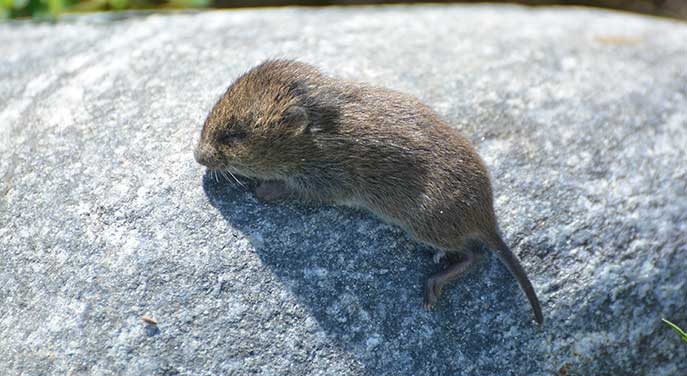 It’s easy to admire big animals, but without tiny critters nothing can survive. From the soil insects, micro-organisms and small mammals that become food for predators up through the food chain, everything relies on something smaller to survive.
It’s easy to admire big animals, but without tiny critters nothing can survive. From the soil insects, micro-organisms and small mammals that become food for predators up through the food chain, everything relies on something smaller to survive.
One of the most overlooked mammals is the Meadow Vole. It’s a small mouse-like animal that lives in fields, damp wetlands and forest edges. It is a primary food source for most larger avians, many mammalian predators, and even several reptiles and amphibians!
How do you know if it’s a mouse or a vole? Voles have small eyes and ears, a stocky body, and a tail shorter than their body, while mice have large ears and eyes, a lean body, a tail longer than the body and often have a more varied coloured pelage (i.e. fur). Mice are more tolerant of people and often come into homes and cottages, whereas voles generally stay out in the fields.
Found virtually across all of Canada and much of the northern U.S., the Meadow Vole is an integral part of many landscapes. Uniformly dark brown in colour, its features are hard to discern, but if you see a dark brown, short-tailed ‘mouse’ running through the grass at high speed, and it is about five to seven inches long, then it is likely a Meadow Vole.
 |
 |
| Related Stories |
| Can beavers catch chronic wasting disease?
|
| What the heck are jumping worms?
|
| Passion for nature sparks a career in environmental education |
Subject to incredible variations in local population numbers, it is a prolific breeder and can breed when only 20 to 25 days of age! According to Penn State experts, “Gestation (of litters that range from two to 11 pups) takes less than a month. Females may mate almost immediately after giving birth, and so, after weaning one litter (which takes 21 days), she may then have another right away. It is possible for a female Meadow Vole [in southern Canada] to have … eight litters” in a single year! But factor in that almost every predator seeks out this tiny morsel and that at 57 to 110 grams in weight, it takes a lot of them to keep hungry predators satisfied. You can never have too many.
The young are born naked and blind, and the fur starts to appear after three days. When about a week old, they open their eyes and start to crawl, and when about 14 days old, they are weaned off milk and begin to consume solid food. The main summer components of their diet are grasses and sedges, but in winter, they switch to grains, seeds, bark, roots and dried fruits.
They do not hibernate, so they must feed every day. Voracious eaters, they consume, on average, 60 per cent of their body weight daily! The female’s home range is tiny and averages about 400 sq. ft. (37 m2), so an average urban yard can represent the entire home range of a single vole. On the other hand, males are not as range restricted and will wander freely between territories ensuring genetic variability in the population as a whole.
Meadow Voles poop a lot; this is an essential source of nutrients for grasses and other plants where the voles forage. Significantly, voles accelerate the dispersal of vital mycorrhizal fungi (e.g. a fungus that grows in association with the roots of a plant in a symbiotic relationship) in the soil and thus influence the survival and growth rates of many important species of trees.
Meadow Voles are most abundant in shrub and field ecosystems when these unique habitats are in their early transitional stages where fields eventually become forests. The presence and activities of voles greatly influence the rate and scope of subsequent habitat stages based on their input of nutrients, dispersal of seeds and ‘pruning’ activities as they nibble on winter shoots.
So next time you let your cat out and it kills a ‘mouse,’ maybe think for a moment about what hawk, owl or fox was deprived of a meal as a result – but that’s another topic.
Geoff Carpentier is a published author, expedition guide and environmental consultant. Visit Geoff on LinkedIn, Instagram and Facebook.
For interview requests, click here.
The opinions expressed by our columnists and contributors are theirs alone and do not inherently or expressly reflect the views of our publication.
© Troy Media
Troy Media is an editorial content provider to media outlets and its own hosted community news outlets across Canada.

